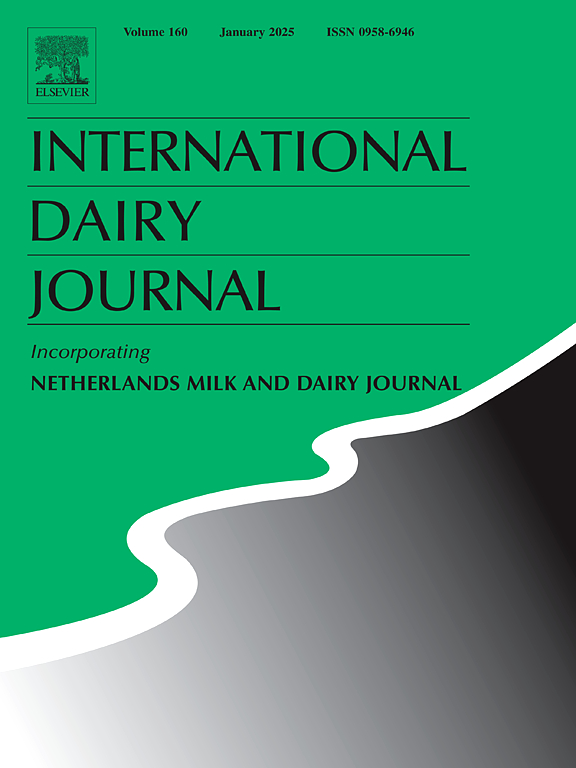β-galactosidase from Bifidobacterium bifidum for improved in situ synthesis of GOS-oligomers with prebiotic effects
IF 3.1
3区 农林科学
Q2 FOOD SCIENCE & TECHNOLOGY
引用次数: 0
Abstract
A novel β-galactosidase from Bifidobacterium bifidum with high transgalactosylation activity was investigated and compared to already available commercial β-galactosidases for GOS-production. The enzyme showed suitable characteristics for in-situ GOS-production in neutral dairy products. The β-galactosidase investigated here, resulted GOS yields of >53.8%w/wcarbohydrate during in-situ conversions in milk at cold conditions (5 °C) and during GOS-syrup production at high temperatures (55 °C). The GOS-fiber yields (having a degree of polymerization ≥3) reached with this enzyme in milk was sufficient for a relevant sugar reduction based on lactose (>35% reduction) and for a dietary fiber claim. Furthermore, structural analysis of the produced GOS from this enzyme revealed a unique pattern of GOS structures. The β-galactosidase from B.bifidum was estimated to have a high preference for β-1→3 linkages. This indicates a reduced allergenicity risk as compared to GOS from other enzymes. Additionally, the GOS formed by the β-galactosidase from B.bifidum, showed a similar behavior compared to commercial GOS from Bacillus circulans in simulated gastric and small intestine studies as well as a similar responses in a simulated large intestine study. The results therefore suggest a well-suited application of the β-galactosidase from B.bifidum in dairy products.
从两歧双歧杆菌中提取β-半乳糖苷酶,用于原位合成具有益生元效应的gos低聚物
研究了两歧双歧杆菌中具有高半乳糖基化活性的新型β-半乳糖苷酶,并将其与已有的用于gos生产的商业β-半乳糖苷酶进行了比较。该酶具有在中性乳制品中原位生产氧化石墨烯的良好特性。本文研究的β-半乳糖苷酶在低温条件下(5°C)和高温条件下(55°C)的牛奶原位转化过程中,GOS的产率为53.8%w/wcarbohydrate。该酶在牛奶中达到的gos纤维产量(聚合度≥3)足以实现以乳糖为基础的相关糖还原(减少35%)和膳食纤维的要求。此外,对该酶生产的GOS进行了结构分析,揭示了其独特的GOS结构模式。双歧杆菌中的β-半乳糖苷酶对β-1→3键具有较高的偏好。这表明与其他酶相比,GOS的致敏性风险降低。此外,两歧双歧杆菌β-半乳糖苷酶形成的GOS在模拟胃和小肠研究中表现出与环状芽孢杆菌的商业GOS相似的行为,在模拟大肠研究中也表现出类似的反应。因此,结果表明双歧杆菌β-半乳糖苷酶在乳制品中的应用是非常合适的。
本文章由计算机程序翻译,如有差异,请以英文原文为准。
求助全文
约1分钟内获得全文
求助全文
来源期刊

International Dairy Journal
工程技术-食品科技
CiteScore
6.50
自引率
9.70%
发文量
200
审稿时长
49 days
期刊介绍:
The International Dairy Journal publishes significant advancements in dairy science and technology in the form of research articles and critical reviews that are of relevance to the broader international dairy community. Within this scope, research on the science and technology of milk and dairy products and the nutritional and health aspects of dairy foods are included; the journal pays particular attention to applied research and its interface with the dairy industry.
The journal''s coverage includes the following, where directly applicable to dairy science and technology:
• Chemistry and physico-chemical properties of milk constituents
• Microbiology, food safety, enzymology, biotechnology
• Processing and engineering
• Emulsion science, food structure, and texture
• Raw material quality and effect on relevant products
• Flavour and off-flavour development
• Technological functionality and applications of dairy ingredients
• Sensory and consumer sciences
• Nutrition and substantiation of human health implications of milk components or dairy products
International Dairy Journal does not publish papers related to milk production, animal health and other aspects of on-farm milk production unless there is a clear relationship to dairy technology, human health or final product quality.
 求助内容:
求助内容: 应助结果提醒方式:
应助结果提醒方式:


